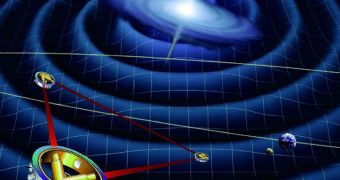A new experiment carried out at a NASA lab demonstrated that it's possible to use lasers to listen in on the “music” made by gravitational waves as the pass through the Universe.
These structures were predicted to exist in the early 20th century by famed physicist Albert Einstein, who predicted that they were ripples in space-time that were produced when the Big Bang occurred.
Physicists have been curious as to whether these formations actually exist for many years, and experts at the NASA Jet Propulsion Laboratory (JPL), in Pasadena, California, recently demonstrated that at least the search for the waves is feasible.
In a JPL lab, researchers constructed a laser system that is a precursor to the one which will fly aboard the future Laser Interferometer Space Antenna (LISA) satellite array. The mission will include several spacecraft flying in formation.
Theoretically, gravitational waves should produce at least subtle signals in the background noise of the Universe, and experts believe that they can be detected using laser interferometry.
But the task is not at all easy, and many challenges need to be overcome if LISA is to have any chance at success. What the JPL experiments found was that random fluctuations in the system's laser beam can be silenced to the point where the waves' signals become “audible.”
“In order to detect gravitational waves, we have to make extremely precise measurements,” explains JPL physics expert and research team member, Bill Klipstein.
“Our lasers are much noisier than what we want to measure, so we have to remove that noise carefully to get a clear signal; it's a little like listening for a feather to drop in the middle of a heavy rainstorm,” he adds.
Klipstein is also the coauthor of a new research paper detailing the finding, which was published in a recent issue of esteemed scientific journal Physical Review Letters.
When LISA will be deployed, it will feature three small satellites arranged in a triangle-like configuration, each of which will be connected to the others via laser beams. The spacecrafts will be located on an orbit around the Sun.
Inside each satellite will be a gold/platinum cube, that will float freely in space. When the waves will crush into them, it will move them in one direction or the other by a tiny amount.
The lasers will be so sensitive that they will be able to pick up these minute differences, and therefore identify the gravitational waves.
“The gravitational waves will cause the 'corks' to bob around, but just by a tiny bit. My friend once said it's sort of like rubber duckies bouncing around in a bathtub,” says JPL research scientist and study coauthor Glenn de Vine.

 14 DAY TRIAL //
14 DAY TRIAL //